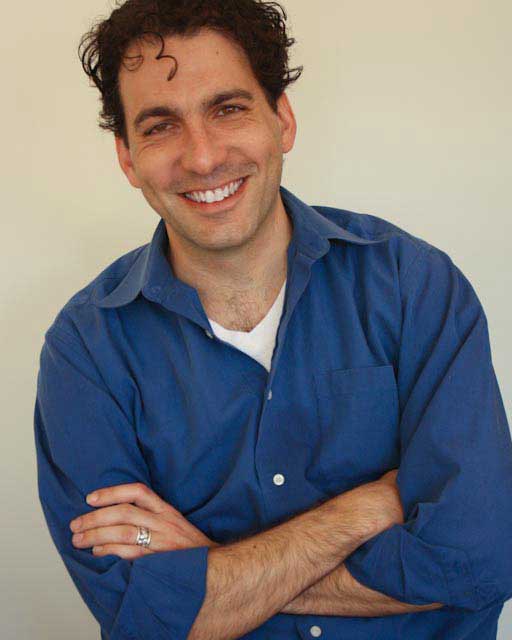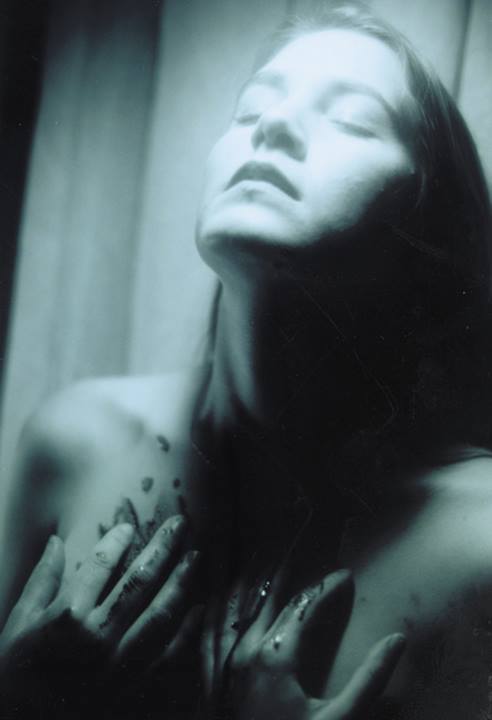
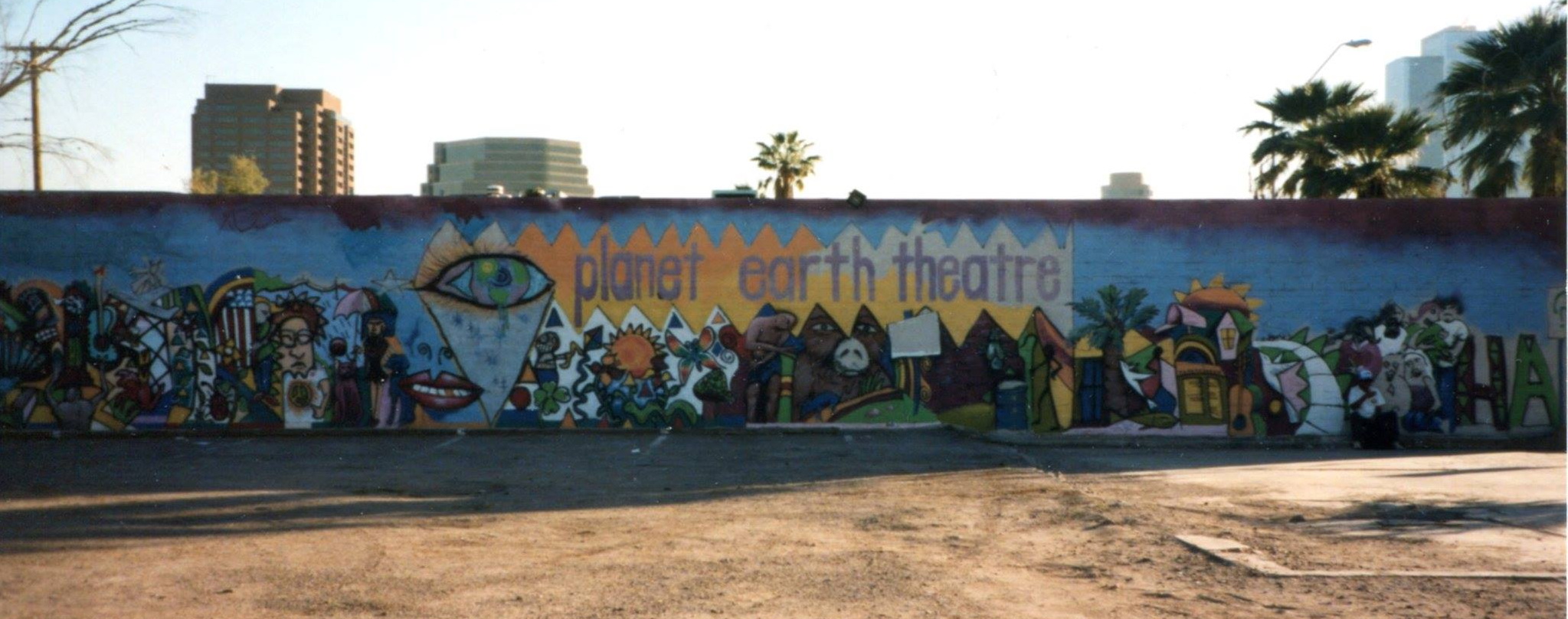
I would like to express my appreciation to Mollie Kellogg for her help in developing this page.
From roughly 1992 to 1997, Phoenix boasted a theater company like no other it had seen – or would see again.
Planet Earth Theatre, or to give it its full name, Planet Earth Multicultural Theatre, could have been called avant-garde (and was). It could have been labeled surreal (and was). It could have been snidely referred to as the birthplace of over-the-top, outrageous, gratuitous wackiness (and was).
It also was very serious about theater-making. New plays were the norm. If the productions weren’t premieres, they were bold, usually shocking retakes on the classics. The company’s post-modern revamp of The Tempest caught critics and audiences off guard, earning good reviews and satisfyingly full houses. Its voodoo Medea may well have been the most provocative theatrical production in the city’s history.
The productions at Planet Earth did not push boundaries, they started outside them and went from there. They jumped off the cutting edge without an idea as to where they would land or if they would survive the fall.
Though there were others involved, most notably Christopher Haines, now head of iTheatre Collaborative, Planet Earth was the baby of director/creative genius Peter James Cirino and his (now ex) wife, Mollie Kellogg, one of the most striking, original actresses to grace a Phoenix stage.
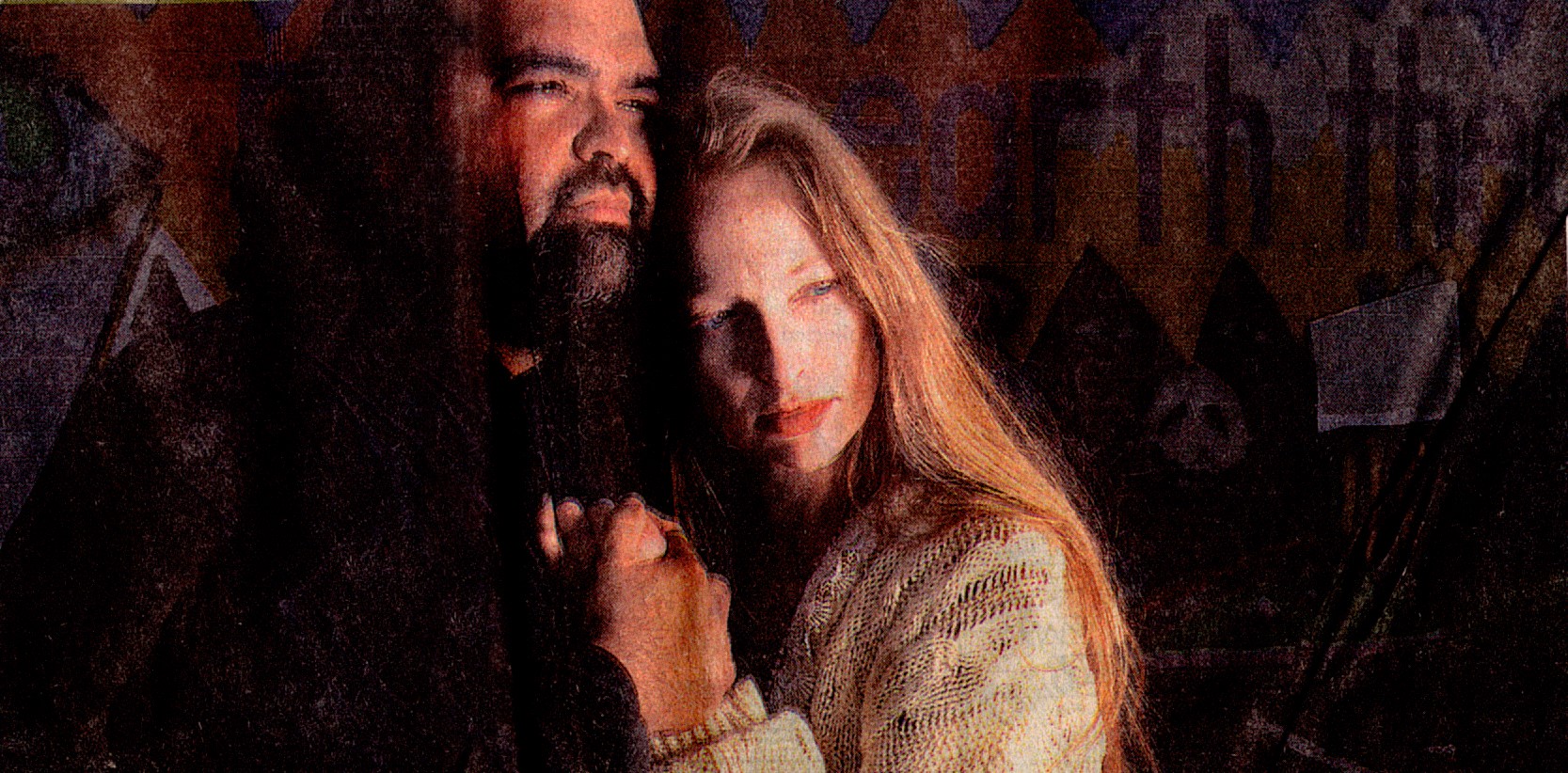
They never had a dime to call their own. Most Planet Earth productions were created out of sheer imagination. Peter was famous for dumpster-trolling, looking for material that could be fashioned into sets, costumes or props.
The lighting was a step up from tin cans holding light bulbs but not much. The sound equipment was courtesy of the designers who brought their own or resorted to mix-and-match gizmos that turned the floor into a hazardous maze of undulating cables. The seats were mismatched and frequently unreliable folding chairs until movie theater mogul Dan Harkins donated some chairs from one of his theaters that was undergoing an upgrade.
Planet Earth was probably best known for the graffiti-style mural that adorned the exterior of its building at Third Street and Roosevelt Avenue. The structure stood alone among weed- and broken-glass-filled lots. Parking was an adventure and not without danger. The immediate area was home to cruising gays. Transgendered individuals were prominent. Peter and Mollie often invited them to attend the plays. They lolled about the lobby, adding a touch of edgy glamor to the place.
Inside, the theater resembled nothing so much as a post-apocalyptic battleground, all naked concrete and exposed pipes and ducts. The electrical system was not shy about making itself visible, snaking up the walls and across the ceiling. The floors bore strange markings and deep, rough-edged chinks that were challenging to navigate.
The folding chairs, and later the theater seats, perched on risers that caused the hair to rise on my neck. Rickety is a good word. Adventurous is another. One night, one of the bleachers partially collapsed. Audience members picked up their chairs and moved them to another location. The show went on. That was Planet Earth.
No description of the theater would be complete without a mention of the rest rooms. Rest room, actually. It was unisex, and spartan. (OK, the vibe was “wrecked.”) With transgendered patrons and the homeless standing in line, along with actors who couldn’t outwait nature’s call, intermission breaks at Planet Earth were a theater onto themselves.
The amazing thing was that audiences found this unconventional space. On any given night, you could see older couples from Scottsdale, ASU students and street people who came in to get warm and maybe a handout from Mollie, who was hopelessly sentimental about such things.
(These homeless folks sometimes found themselves repaying her kindness by ending up on stage. If Peter was desperate for bodies to fill out a cast, he turned to them, sometimes with surprisingly good results.)
People often ask me about the most memorable moments during my 30-plus years as a Phoenix theater critic. Two of them involve Planet Earth.
One was an overtly gay version of Christopher Marlowe’s Edward the Second. Long before Nearly Naked Theatre made it respectable (well, almost), nudity was flaunted at Planet Earth. This production could have called the Naked Edward and it would only have been truth in advertising. It also was uncompromisingly sexual. That memorable moment? Two male actors simulating intercourse about two inches from my big toe. They didn’t need extra lighting or heating units that night. My face took care of both.
The other moment was much more affecting. Peter championed Hispanic playwrights when most companies here pretended they didn’t exist. His was the first local production of Maria Irene Fornes’ devastating The Conduct of Life. The play involves a military man from an unspecified Latin American country who kidnaps an underage orphaned girl and proceeds to brutally abuse her claiming he’s doing it out of love.
It is an allegory, metaphor, what you will, for the whole right-wing dictatorship thing in South America, but in real time, it is an excruciatingly painful thing to observe. Edee Trejo Cadin, portraying the girl, was brilliant; she was an adult but she looked all of 12. As the torture scenes proceeded, I was gripped with an emotion that I had never felt in the theater. I couldn’t look. I wanted to bolt the theater and throw up in the parking lot. It was the single most horrifying, life-affecting moment of my critical career. From that night on, I have despised the right wing of any institution, political or social. I still dream of those scenes. The experience haunts me.
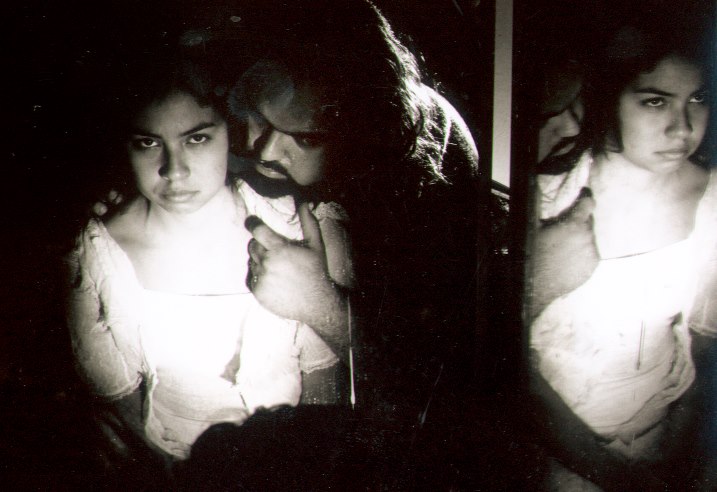
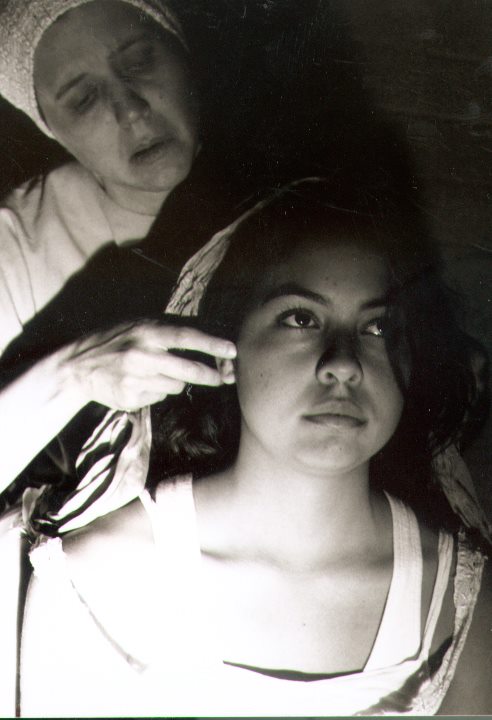
In many ways, Planet Earth was doomed from the start. Sooner or later, the building was bound to fall victim to the wrecking ball. The city never considered it as anything but an eyesore. More importantly, there simply wasn’t an audience for its visions that was large enough to pay the bills. Peter and Mollie became tired of being called “that weird couple from that weird theater.” Eventually, they gave up the fight. Relocating to Seattle, divorcing, becoming a teacher in California (him) and a highly regarded artist (her), they moved on.
But for a brief time, their star blazed brightly and Phoenix was propelled into a world so provoking, so challenging that it probably can never be resurrected in quite that way.
Some might call the Planet Earth experiment a plunge into the abyss. They’re wrong. It was a key that unlocked corners of the mind that cried out for light. It was a knife that pierced carnal obsessions and explored them as avenues of redemption. It was an open door to a universe that was as thrilling and fulfilling as it was frightening,
It was theater. Total theater. Real theater.
*****
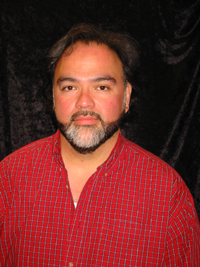
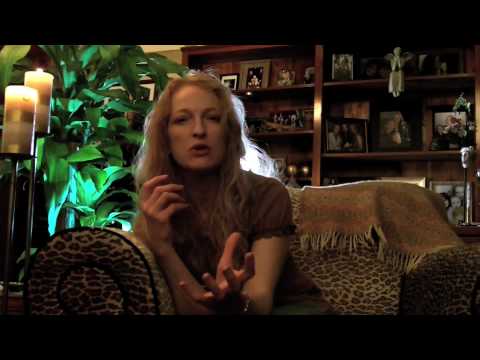
Memories from Mollie Kellogg
Part of me wants to now draw the curtain on those memories and get back to my any.do list of about two-dozen-plus fine art and short film tasks that have been my focus for the past decade. Another part of me realizes that, even though it involved only about five years in Phoenix, a couple more in Seattle and a fleeting moment in San Diego, PET was something very special, and other than as dusty memories in the minds of a few dear friends and critics, I am the only one with this rag-tag digital archive.
I will indulge the roller-coaster of personal emotions and artistic memories that accompany these images, as this wasn’t just a theater, this was my life, my marriage and kids. Extreme highs and lows were not left at the stage door for ten years. And once I have posted the photos, (tearing up now and then), and told my stories, then I will return to my wonderful life here-and-now and thank the Goddess for that amazing journey.
Thoughts concerning the relocation to Seattle:
PET Seattle produced several shows, participating in Fringe Festivals and the Telluride Festival with original works, but due to the sky-rocketing property prices, never had its own space. I think this lack of “home” ultimately was the reason PET Seattle did not thrive.
*****
For my 2004 article on Planet Earth and the Valley’s alternative theater scene that appeared in the Arizona Republic, go HERE
*****
For a selection of Planet Earth videos, go HERE
*****
Upon reflection, I am sure that Planet Earth’s production of Maria Irene Fornes’ The Conduct of Life had the most impact on me of anything I saw during my years as a critic. Out of this production were formed my enduring views on the treatment of women and the dangers of right-wing ideology.
Mollie Kellogg’s memories of The Conduct of Life
I believe Edee won an ariZoni Award for this performance and it was well deserved. Pictured with her above is Peter Cirino. Also in this show was David Gonzales, who accidentally took the butt of a prop gun to the back of the head. It was, as Kyle reported, an intense, intense show. Amnesty international had a display on female genital mutilation in the lobby. Pablo De Ocampo assistant directed. I was originally in the cast as the maid, but pulled out of the show. Partly due to fatigue and partly to the emotional impact of watching Peter in this role night after night. With any other actor, I would have been OK – but our emotional energies, being married at the time, were too entwined.
*****
Note: Many companies besides Planet Earth used the facility. Scroll down for any material I have on those productions.
*****
PHOTOGRAPHS, REVIEWS & THE KITCHEN SINK
Many of the artists listed below are mentioned on other pages on the website. Type their name into the search box at left.
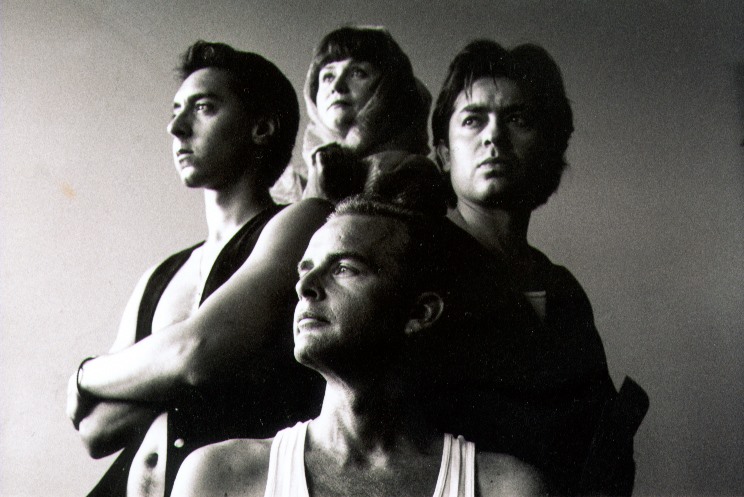
From Mollie Kellogg: This is a photo I took for Blood Wedding, performed at the 3rd Street Theatre before Bradley C. Golden and Peter Cirino found our building. David A. Akin, Ceasar Hernandez and Bruno Cisneros were in the cast. I do not recall the actress in the back. This photo was taken at Marilyn Szabo’s studio where we rehearsed. I was pregnant with my first child, Oni, during this production.
This was our second show as Planet Earth. Our first was Friendly Divorce by Terry Earp at Raymond King Shurtz’ Playwrights Theatre, across from where we lived. Although, somewhere in there. Bruno and I performed Quintuplets on Playwright’s stage (later David Akin and I would also perform Quintuplets at the Willow House, to a very large crowd thank to Wyatt Earp’s public relations efforts.)
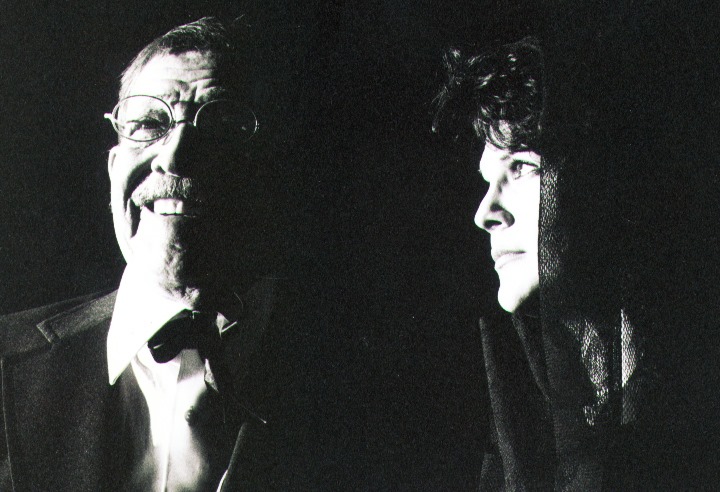
*****
1997. “Haunted Summer.” Directors: Peter James Cirino, Christopher Haines. Cast: Mollie Kellogg, Christopher Haines, Sean Robbins.
The original script was fashioned by directors Cirino and Haines from improvisations by the cast and crew.
Note: For Robrt Pela’s Phoenix New Times article on this production, go HERE
*****
1996. “Witch Holiday.” Cast: Mollie Kellogg, Precious Morris, Josh Feinman.
Mollie Kellogg remembers …
Witch Holiday also sprouted from the Writer’s Group written by Laraine Herring. I and Precious Morris were in her cast along with Josh Feinman.
I performed Laraine’s Guest of Honor:
Since her days with Planet Earth, Laraine has concentrated on writing books. Her website can be reached HERE
*****
1996. “The Tempest.” Directed by Peter James Cirino. Music Director, Chris Nelson. Produced by Mollie Kellogg & Peter James Cirino. Set Designer: Larry Lopresti. Cast: Mollie Kellogg, Christopher Haines, Joseph Benesh, Shel Bailey, Suze St. John, Josh Feinman.
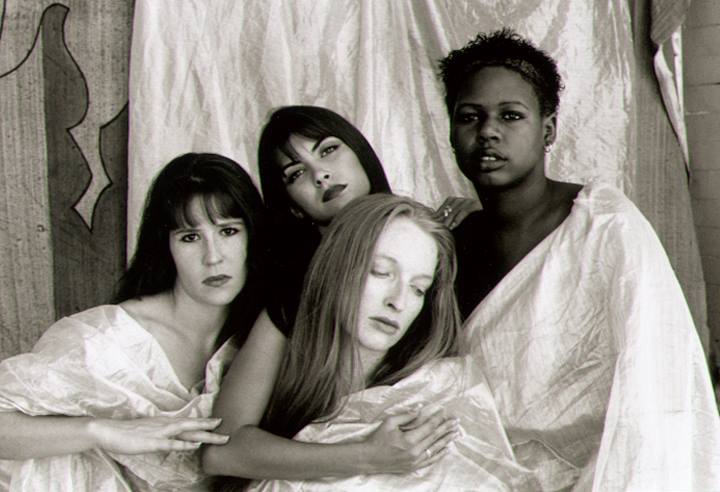
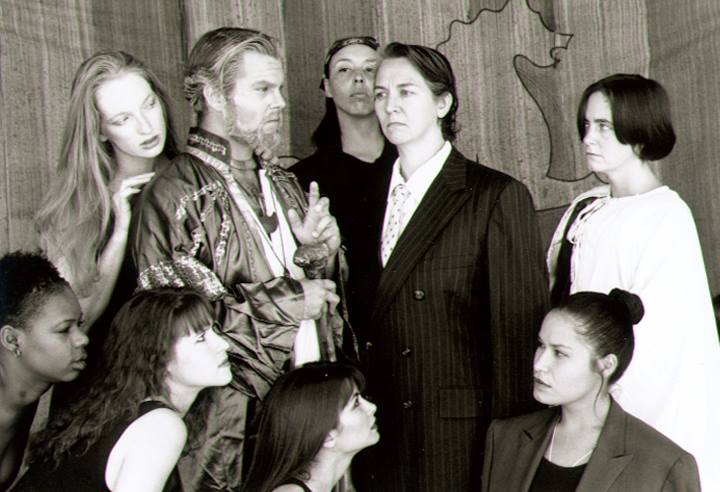
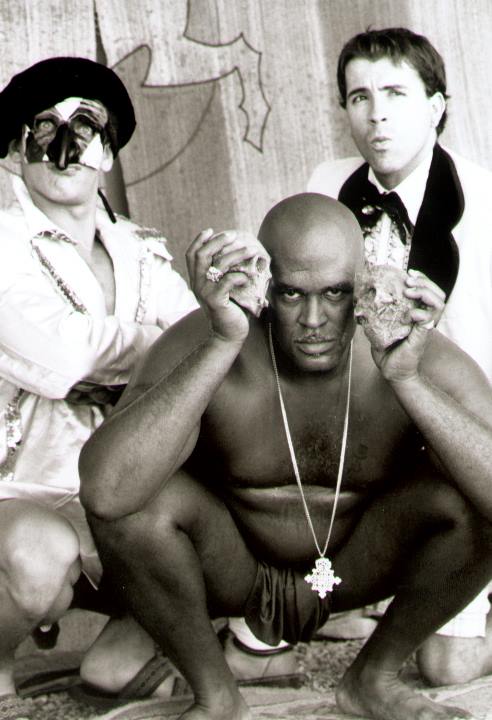
Mollie Kellogg remembers
I played Ariel, usually played by a male. PET blind cast, so it was not uncommon. I got to dance and sing and wear pretty dresses. Most folks who were uncomfortable with my more edgy PET roles, liked this one.
However, one of those pretty dresses almost burnt down the theater during a performance! We had huge swamp coolers on wheels for the storm scene and as I existed the stage my skirt was sucked into the unit and started to smoke, with me still trapped in the dress! A fellow actress, whose name I can not recall the name of, (she also appeared as a bag lady in David Gonzales Birthday short film), came up behind me and ripped my dress off of me. I jumped out of the dress and, half-naked, ran around the back of the stage to get into another costume and make my next entrance as the smoking cooler was unplugged and whisked out the back door.
Great cast, including Christopher Haines as Prospero, Joseph Benesh, Josh Feinman and many more.
Here is a sample of that production. Other material from the play is available at youtube.com.
*****
1995-1996 SEASON. “Antigone” Director: Peter James Cirino, Cast: Mollie Kellogg, Timm Rogers, Joy Bingham Strimple.
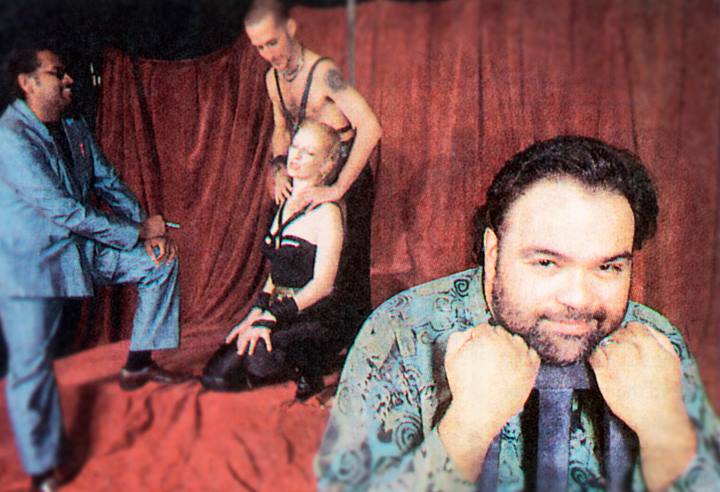
For Robrt Pela’s review of Antigone in the New Times, go HERE
*****
1995. “Waiting for Godot.” Directed by Peter James Cirino. Cast: Christopher Haines, Mike Traylor, Mollie Kellogg, Kent Kemmish.
Mollie Kellogg remembers …
In Waiting for Godot, I also go to whip Kent Kemmish while riding on his shoulders as he wore a diaper and a helmet, (Gosh, I hope that happened.) I do not have good shots of Godot with Christopher Haines and Mike Traylor, who, like me, was a Maryvale Thespian. I played Pozzo and I felt soooo bad for Mike and Chris – I was pregnant, nauseous and could not remember my lines — this is not the play for that! But, I muddled through, and they are both such good actors, they rolled with it and made me look good. I think Dawn Pomeroy and Rick Tobin danced in Godot as well.
For Marshall W. Mason’s review in the Phoenix New Times go HERE
*****
1995. “Medea.” Directed by Peter James Cirino. Music: Luis A. Hernandez. Cast: Mollie Kellogg as Medea, David A. Akin as Jason, Shel Bailey as Black Spirit, Diane Contreras Harris as Sister Nanina. Scenic Design: Mario Gallegos. Videography: Matthew Karges and David Gonzales.
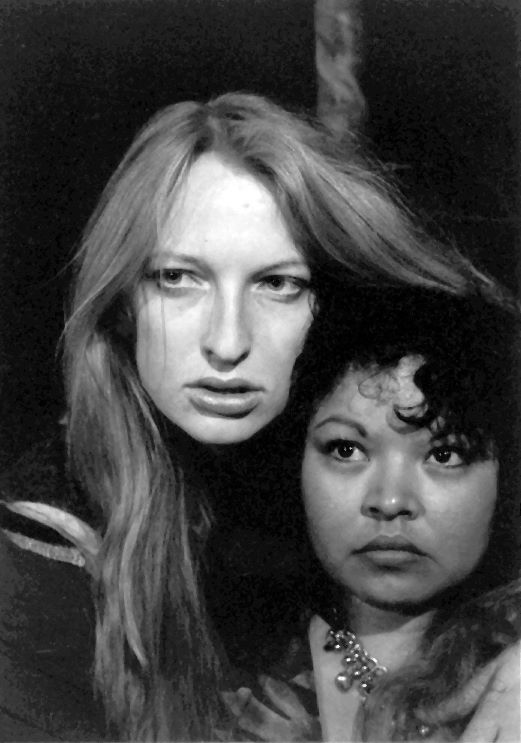
Note from Mollie Kellogg: Medea was presented by Planet Earth Theatre in 1995, directed by Peter James Cirino. Included in these PR photos are Dawn Pomeroy top center and Lucy LaMode bottom left. (If you recall the names of the others, please comment.) I was Medea and Jason was played by David A. Akin. Our performance was sited in Reimagining Greek Tragedy on the American Stage By Helene P. Foley.
Marshall W. Mason reviewed this show for the New Times (one of the few good reviews that made it to the web – seems the bad reviews have the on-line shelf life of Twinkies).
I was pregnant with my son, Petyr, during the run. (After each performance I would assure my unborn son that I was just pretending.) This show was in April and in July I was hospitalized with preeclampsia and my son was born two and a half months premature. Following his birth I developed HELLP syndrome. My son was in the PICU and I in the ICU. While in intensive care, Peter’s episode of the TV show Legend with Richard Dean Anderson aired and every time he had screen time, I pushed the call button and the nurses would rush in and I would point at the TV screen.
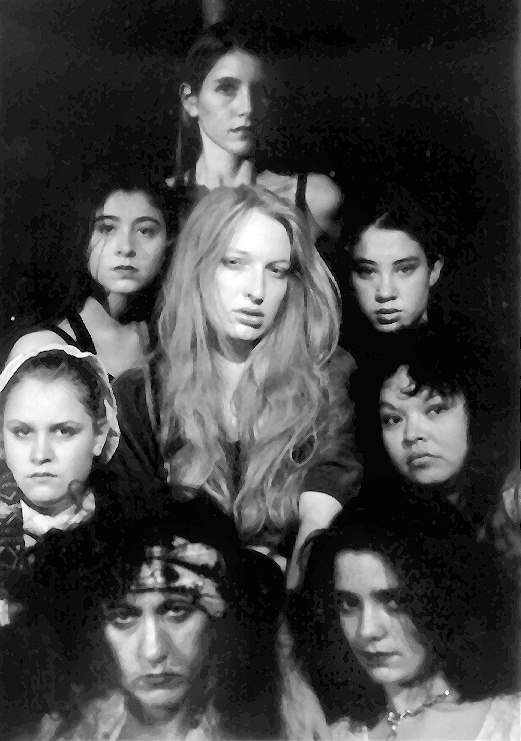
REVIEW by Marshall W. Mason, Phoenix New Times, April 20, 1995.
The sensational story of Medea has fascinated audiences throughout time. Corneille wrote a version in 1635, and Cherubini turned it into an opera in 1797. Broadway has produced this play more often (and more successfully) than any other classic. Dame Judith Anderson won a Tony Award as Best Actress in 1948 in the Robinson Jeffers adaptation, then played the Nurse to Zoe Caldwell’s 1982 Tony-winning Medea. Only last season, Diana Rigg won a Tony in the latest revival. Maria Callas starred in the 1970 Pasolini film, and even Charles Ludlam wrote a version in which Everett Quinton and Black-Eyed Susan alternated as Medea and the Nurse. There are even rumors of a rock musical Medea in the works.
As Susan Smith goes on trial in South Carolina for murdering her two children, it is no wonder that Medea remains the most modern of ancient plays. Although Euripides wrote it in 431 B.C., it is as relevant as a tabloid headline.
And now Planet Earth Multicultural Theatre is presenting a voodoo version, written and directed by Peter James Cirino and starring Mollie Kellogg Cirino in the eponymous role. The story of Medea concerns the misbegotten love of the woman for her husband, Jason. She has used her magic powers to save this heroic adventurer, rescued him from danger and helped him to carry home the Golden Fleece. She has also borne him two children, and he has brought them all home with him, far from Medea’s homeland. Persuaded by Creon that there are considerable advantages to be had from marrying his daughter, Jason abandons Medea to marry the younger woman, ostensibly to contrive a better life for his children. Filled with jealous rage, Medea can think of no more effective way to destroy her faithless husband than to use her magic powers to slay his bride and her father, and then to perform the most unimaginable act our culture can contemplate: kill her own children.
Peter Cirino has found a contemporary equivalent of the superstitions on which the ancient text was based by transplanting the action to Louisiana and the Arawak culture of the Caribbean. He has made use of every feather, candle, incense, symbol, icon, amulet, rune, smoke and mirror he could enlist. Using the claustrophobic confines of the Planet Earth space, he and his designer, Mario Gallegos, have created an environment that eerily invokes a den of sorcery. Even in the entrance to the theatre, lights flicker, strange symbols hover and mystery hangs in the air. Dried palmetto fronds whisper with a dry, scratching murmur.
In one corner, a blood-red spot highlights the bare arms, chest and legs of a conga drummer, whose tight muscularity is both sensual and threatening. Luis A. Hernandez pounds out relentless rhythms that accompany the action of the entire play.
Medea is for actresses what Hamlet is for actors, and Mollie Cirino steps up to the plate with relish. Her angular features drawn by grief, Cirino performs the rituals of Santeria, a blending of voodoo rites and beliefs with Catholicism, peculiar to the Arawak culture of the Caribbean basin. I once saw a Santeria festival in Bahia, Brazil, that greeted the coming of spring. It involved floating candles on the calm sea, incense in the fragrant night air and a great deal of chicken blood. If you saw the film The Big Easy, you will have some idea of the rituals involved in this mysterious practice.
Silently, her eyes simmering with dread of what she must do, Cirino blends the herbs and smoke into the spells of this dark religion. Under her touch, symbols threaten with ominous power. And when she does give utterance, the cries come from her bowels. Suddenly, Cirino’s talent blazes into being, and Medea becomes flesh before our very eyes. Cirino is transcendent in her incarnation of a woman scorned. She makes her jealous rage an inevitable result of the betrayal of love, and pursues her revenge with a dedicated malevolent logic.
The production is aided enormously by the most sympathetic Jason I have yet seen. It is clear from David A. Akin’s performance that Jason really does love Medea, and that he cannot turn down the offer to make his children princes. Akin endows Jason, usually played as a boor, with depth and dignity that make you understand why Medea cannot let him go.
Shel Bailey is a towering black spirit with a basso profundo voice like that of Geoffrey Holder (of the 7-Up commercials), and it is he who supervises the spells and charms enacted by the cast. He is easy to believe as the godfather of sorcery.
The Nurse is named Sister Nanina in this version, and is played with warmth by Diane Contreras Harris. Only an incompetent trio of amateurs that makes up the chorus mars this primitively powerful production.
One problem with mounting the play of Medea is finding a way to depict the children in a way that engages our horror when they are slaughtered. Many times, an audience may be tempted to feel relief to see the brats get theirs. Peter Cirino has put the children on television monitors, so we see them only in close-up. This gives videographers Matthew Karges and David Gonzales an opportunity to depict their annihilation with superimposed abstract imagery. While this is a novel idea, it didn’t quite work on opening night, partly because of technical difficulties, but also because it keeps us from ever feeling very personally about the children. They become just one more media image, and their deaths lack the power of, say, the Rodney King beating.
Still, this is the crowning achievement of Planet Earth theatre for this season, and although I must confess the seductive incense and lull of the conga drums had me drowsy from time to time, this is a Medea that fully captures the mystery and majesty of this masterpiece.
Comments from the public:
Gerry Hitt I don’t know how I missed this show as I had picked Medea for my full length play production in my senior year as a theater major at the U of U. I had the actress in mind for Medea, as I had acted in Desire Under the Elms by Eugene O’Neill for her. The only thing that prevented me from doing it was being taken unexpectedly off to the psych ward which abruptly terminated my university of life, and that turned out to be an even bigger drama than doing Medea would have been! I think you would have made a wonderful Medea.
I also saw the Maria Irene Fornes play, Conduct of Life, the same night Kyle did, which performance he talks about in his article about Planet Earth. I thought Peter was riveting in that role. And I applauded him for bringing this great woman playwright to Phoenix with Conduct of Life. One of the best plays I have ever seen in Phoenix. Unforgettable. Another of my all time favorites I saw at Planet Earth was When cocks have wings and fly or something like that. I absolutely adored that play. Of course I spent 20 years on the west side in subsidized housing in a 90 percent Mexican neighborhood, so I was very interested in Planet Earth productions. Peter introduced us to the great Lorca, too, with Blood Wedding.
I love it when a city has a lot going in theater, and around five critics were reviewing shows then. We did not know they would practically all go away. No reviews in the Arizona Republic today, have to go on line now to find them. Can’t help but think this is not a good trend, from the personal to the impersonal, and to me the more personal the drama the better. My motto for writing plays was live the drama and then record it!
*****
SEPTEMBER 1994. “Danton’s Death” Director: Peter James Cirino.
This adaptation follows the story of Georges Danton, a leader of the French Revolution. The ensemble cast consisted of professional actors as well as the novice.
Christopher Haines (Danton) led the cast with a poetic and passionate performance as the French revolutionary leader. Jeffrey Hartgraves was the sinister Robespierre. Mollie Kellogg (Saint-Just) and Victoria Hunt (Camille) took on cross-gender male roles. Also featured were Edee Trejo Cadin, Kimberli A. Davis-Baker, Rex Whistler and Rick Tobin.
*****
1993-1994 SEASON “Life Is A Dream.” Cast: Mollie Kellogg, David A. Akin, Jeffrey Hartgraves, Pablo de Ocampo.
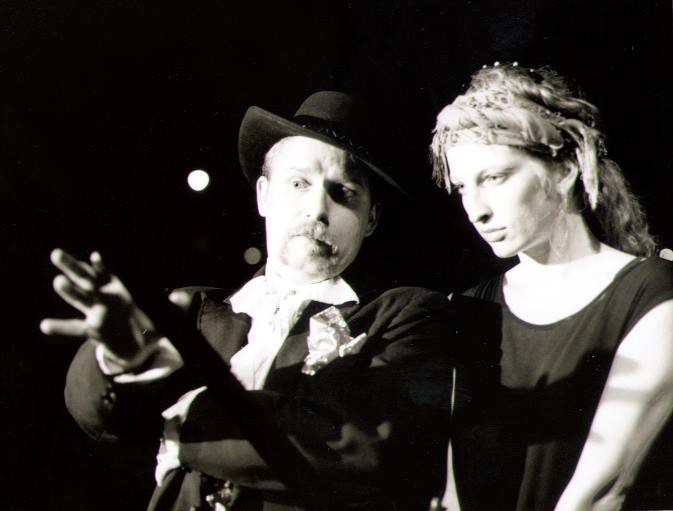
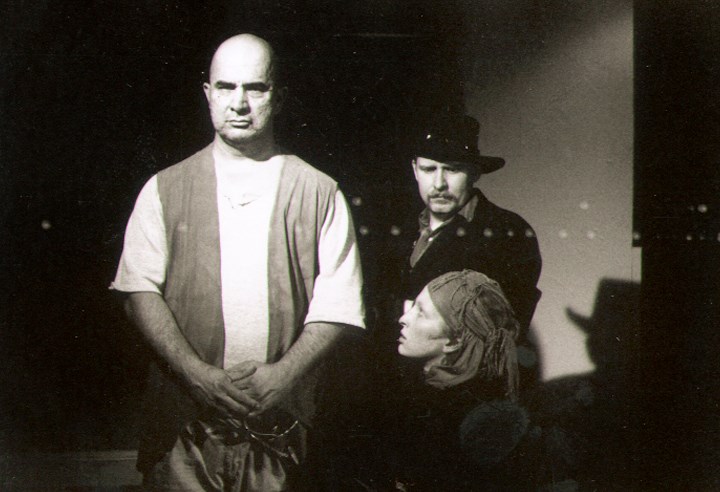
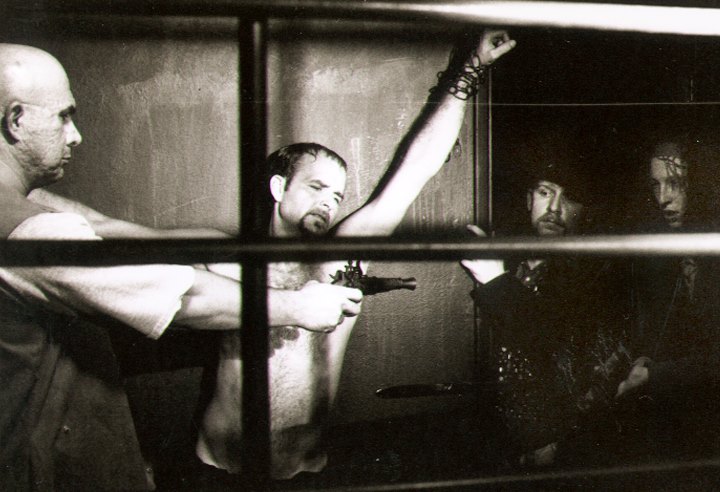
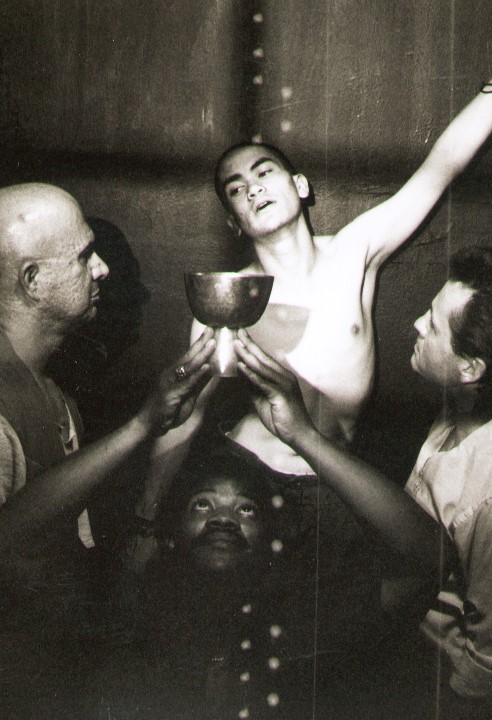
Mollie Kellogg remembers …
Included in these pictures for Life Is A Dream are David A. Akin, Pablo De Ocampo, Jeffrey Hartgraves, and… please add names if you recognize the others. My infant daughter also appeared in this show.
Where the talented David A. Akin was my main leading-man throughout the years, Jeffrey Hartgraves was more-often-than-not my comedic side-kick. I went to the same high school as Jeffery. Both Maryvale Thespians, I remember him being in the pit while I was onstage.
He was part of the PET Writers Circle that included Laraine Herring, Ron Peer, Greg Paxton and David LaSpaluto for a time. They created original works that PET then produced. Jeffery’s scripts broached touching subjects laced with heart-felt humor.
Here is his piece I performed called Pressing Matters.
And here he is performing Intro Retro.
Jeffery and I collaborated on- and off-stage, as we co-directed Motel Tales. Jeffrey left the company and moved to San Fransisco with Brian Chavez. Jeffery and I and stayed in touch and were working on a portrait of him crying, when he fell ill and too-quickly passed from bone cancer. Jeffery was a brilliant talent and touched so many lives and hearts and he is very dearly missed.
This is Jeffrey’s tribute page: Jeffrey Hartgraves Tribute Page
*****
1992-1993 SEASON “Death by Dominatrix”
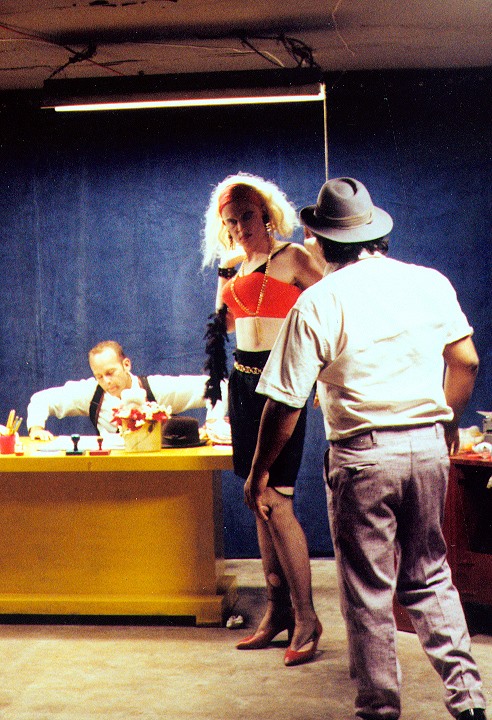
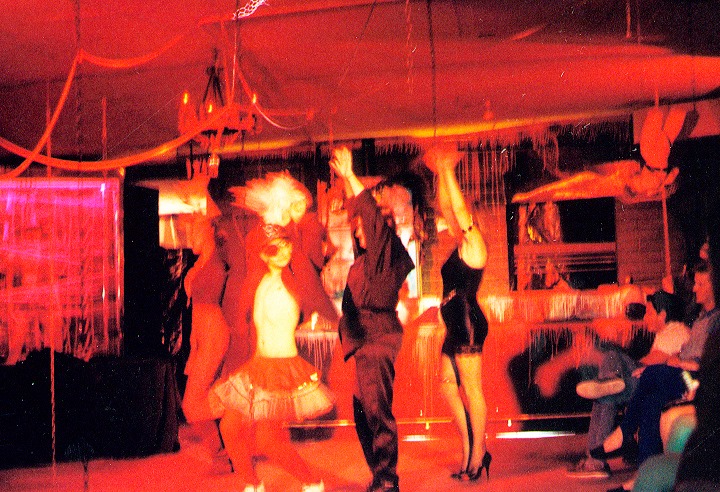
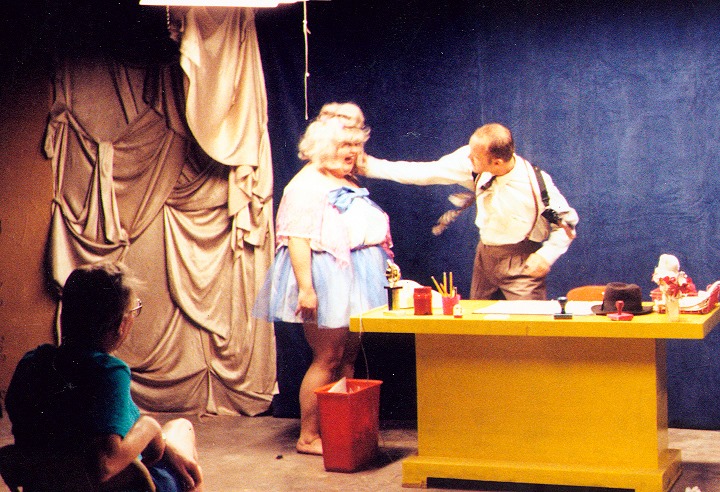

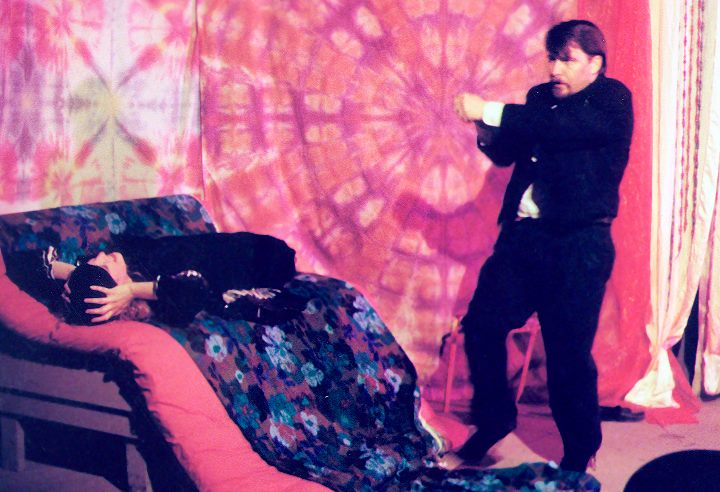
Mollie Kellogg remembers …
Death By Dominatrix. Yep. By Greg Paxton of the PET Writer’s Circle. Highlights include the APEX (Arizona Power Exchange) coming to many performances and going to the Willow House with the cast after shows. While our show was campy fun, they were the real deal, showing up with some members on leashes, refusing to leave until they met me, then and asking if I made David A. Akin “lick my boots”
— I also learned some terms from this audience for sexual acts that I did not even know were a thing. When the show toured to Tempe, APEX followed. At one point, their uninhibited antics sent a skimpily clad male cast member, blocked to dance into the audience, scrambling quickly back onto the stage.
Another memory of this show was the performance where I slipped out of my bustier, while whipping Sean Robbins, and was caught on video. As the character, she wouldn’t care, so I just continued the scene in all my flopping glory. Later at the cast party at Jeffery’s and Brian Chavez’s house, I entered to hear laughter. Everyone was huddled around the television. To my horror, I realize Jeffery and Brian had looped the segment of the video showing me falling out of my costume and added sound effects!!
In these photos are David Akin, Jeffery Hartgraves, Sean Robbins and others. Greg Paxton contributed to our cable-access show Earthquakes. Here is a link to his Coach DuBois:
Since Greg’s PET days, he has written some screen plays. Here is Greg’s IMDB page: http://www.imdb.com/name/nm4617545/
*****
Mollie Kellogg remembers …
My last post about Planet Earth Theatre takes us to Seattle. The photo is of Dead Love at Planet Earth / Seattle Fringe Festival with Dawn Pomeroy, I played the therapist. Yes, it was about necrophilia. Created using the same collaborative method as Haunted Summer.
In our second Fringe Festival show, I played Alice B. Toklas, (in a piece about) about Gertrude Stein, with Sean Cadin as Picasso, and also Edee Trejo Cadin. It was also a collaborative process. I recall rehearsing at Andrea Corrales Parker’s clubhouse at her apartment complex.
In Seattle, the cost of living required me to take full-time employment to support the family and the theater, where as in Phoenix, I maintained my freelance advertising design clients, giving me the flexibility to both support the theater and participate in shows. I then developed a thyroid condition (that later required hospitalization in San Diego). All of these factors amplified the already existing stressors of the relationship. I was not involved in the show White Horse, exploring ideas that Shakespeare did not write his own works, that was mounted at the Seattle Naval Base and went to the Telluride Festival and another festival at the Seattle Center. I do not think Peter and I worked on a production together again until he was hired at San Diego State University and we moved to San Diego.
We talked about creating Planet Earth San Diego, and we worked with the City Heights Performance Annex fund raising for the Friends of the Library, but then we focused our energies towards his professorship and his work with the Globe. I assisted Peter with productions at SDSU for a brief time, up until our divorce. We both remarried, and our kids (want to feel old?); Oni, is now 21 (the little girl waving at the end of some of the Earthquake episodes) and lives in Santa Clarita outside LA, and Petyr, is about to be 19.
Peter is living in San Diego, has two young sons, is a tenured professor at SDSU, and is/was artistic director for the Asian Theater. I live in Spring Valley. I still do advertising design/creative direction, and paint, my page is Artwork by Mollie Kellogg, and have recently participated in shows curated by Robrt Pela and, of course, I still act, direct, and produce short films. Here is my current project page Incognito Witch. Here is my latest: http://vimeo.com/91654241
*****
Earthquakes also featured works by Ron Peer. Here is his Suicide Salad:
One of my most vivid memories of our Sick and Twisted and Over the Edge show, with works from all the playwrights, was a piece by Ron where we, (several male and female actors), were dressed as nuns whacking the hanging testicles of God, (two basketballs hung in a material casing), with a stick. (Who goes to Hell for that one? The playwright, the actors, or the director?) Now-a-days Ron has several writer, producer and director titles to his credt.
Here is Ron’s IMDB page: http://www.imdb.com/name/nm0670278/
Earthquakes included works by several other playwrights, poets, musicians and actors – here is a link to some of those: https://www.youtube.com/user/PlanetEarthTheatre/videos
*****
LIST OF PLANET EARTH PRODUCTIONS
1996-1997
The Tempest by William Shakespeare
Dogg’s Hamlet, Cahoots Macbeth by Tom Stoppard
Witch Holiday by Laraine Herring
The Karaoke Queens at the Saint James by Leo Cortez
Haunted Summer by Peter Cirino, Christopher Haines and Cast
Curse of the Starving Class by Sam Shepard
Lemmings to the Sea by Christopher McPherson
1995-1996
HO– USE OF BERNARDA ALBA. Playwright: Federico Garcia Lorca translated by Peter James Cirino. Director: Peter James Cirino. Cast: Trini Yanez Hale, Cecelia James, Victoria Hunt, Lisa Noelle, Janet Van, Christie Poulson, Bridget Carroll. Comments: Marshal W. Mason’s review in the New Times stated: “Cirino’s production is helped immensely by the authoritative performance of Trinidad Yanez Hale in the title role. She provides the necessary honesty, passion and simplicity to ground the hysteria of the poetry with a glacially majestic presence.”
Sick and Sane Halloween by PET Playwright’s Circle
Ruby Christmas by Sarah Dreher
Antigone by Sophocles
The Ghost Sonata by August Strindberg
Death Watch by Jean Genet
Walking Home by Elaine Romero
Fool for Love by Sam Shepard
1994-1995
Danton’s Death by Georg Buchner translated by Peter James Cirino
Cocks Have Claws and Wings to Fly by Amparo Garcia
Sick and Sane Xmas by PET Playwright’s Circle
Liberating Mama by Laraine Herring
Waiting for Godot by Samual Beckett
Medea by Euripides
1993-1994
Life is a Dream by Pedro Calderon de la Barca translated by Peter James Cirino
Motel Tales by Stuart Ostfeld
Sick and Twisted and Over the Edge by PET Playwright’s Circle
Baltimore Waltz by Paula Vogel
Controlling the Heart a co-production with Deafworks Red Carnation
The Conduct of Life by Maria Irene Fornes
1992-1993
Friendly Divorce by Terry Earp
Blood Wedding by Federico Garcia Lorca translated by Peter James Cirino
Man of the Flesh by Ocavio Solis
Bitter Homes and Gardens by Luis Alfaro
Action by Sam Shepard
Trafficking in Broken Hearts by Edwin Sanchez
DaDa Cabaret Performance Art Weekends
Death by Dominatrix by Gregory Paxton
Each season Planet Earth presented the Off-Night Series that mounted on the current set and played Mondays through Thursdays and Sunday evenings. These we productions brought in by outside companies and artists and co-produced by Planet Earth Theatre.
PRODUCTIONS BY OTHER COMPANIES
1999, “Morning Rituals,” play by Alan Berks. Director April Smith. Cast: Christian Miller, Megan Towle, Stewn Galatro
By Kyle Lawson
The Arizona Republic
The young believe that they will live forever. Given the movies they see, the television they watch, you’d think they’d know better, but the knowledge of their mortality always seems to come as a surprise. Juliet and her kid brother, Jeremy, the protagonists of Alan Berks’ “Mourning Rituals,” can’t believe what’s happening to them. Their father dies in an accident. He is hit by a wind-tossed sign as Jeremy watches, too far away to do anything. Afterward, Juliet conscientiously cares for their cancer-stricken mother, but she dies, too. These seemingly random deaths (“Why them? Why then?”) offend the siblings and frighten them. What is the point of going on when it could all end with a surge of air or with the body consuming itself while the mind watches, helpless to stop the feast? Who can assure them that they, or anyone they love, will last the day? The title suggests that Berks’ drama is about death, but “Mourning Rituals,” whose world premiere is being staged by Blackball Ensemble at Planet Earth Theatre, is more concerned with finding reason to live after the holocaust. Juliet and Jeremy set out on a cross-country odyssey to make sense of chaos. They “investigate accidents,” recording on tape and video survivors’ accounts of what happened. In the privacy of their motel rooms, they replay these again and again, editing them, combining them in different forms. Could these “accidents” have been prevented? If not, was there some plan? Did God, fate or whomever, whatever it is that controls our destinies know what the hell it was doing? Their quest reaches a climax in a seedy Phoenix motel, where the air-conditioning doesn’t work and their nerves wear thin. Their latest interview subject is Guy, who, like Jeremy, has witnessed a tragedy he was unable — or unwilling — to prevent. Guy, too, is investigating the way of things, finding most of his answers in the whiskey bottles he strews in his wake. He is bent on killing himself, though he has hopes of meeting someone who will do him the favor. Berks plays out the confrontation in the manner of the siblings’ approach to their research. The audience is presented replays and edits that wreak havoc with time and place. Dialogue and action sequences that seem fraught with meaning in one scene take on a new dimension when seen and heard in the context of another. It is an ambitious approach that doesn’t always work. In spite of the complexity of the play’s structure, we can see the end coming. In giving us the sociopath we know from countless TV shows and movies, Berks misses the opportunity to confound us with hope. Like his characters, he succumbs to the fashionable pessimism of youth. But then, it is a young man’s play, with many of the faults common to early efforts. Berks, who is in his final year in Arizona State University’s creative writing program, is still gauging the effects of language. His characters’ dialogue can be gripping; it also can be self-consciously arty or unnecessarily obscure. Like many playwrights before him, he has discovered the joys of repetition, which, in moderation, is a good thing and, in this case, even serves as a useful plot device. Unfortunately, he is immoderate in its use. He hasn’t reached the stage where he’s comfortable with letting the audience do some of the work. That aside, it’s refreshing to find a young playwright who has something to say other than four letter words and who doesn’t stoop to baring his characters’ flesh while revealing their souls. You don’t have to be in your 20s or 30s to rail along with Juliet, Jeremy and Guy at the unfairness of life. Anyone who has lost someone will find himself caught up in Berks’ debate. Director April Smith constantly rachets up the tension. If the ending is anti-climactic, it isn’t her fault. Christian Miller creates an appealing Guy, cutting into the audience’s emotions as deeply as he does his own, while Megan Towle’s Juliet has one of those moments actresses live for when she reveals her feelings about her mother’s death. Stewn Galatro’s Jeremy disappoints, but perhaps that is unfair criticism. Berks saddles him with the role of the stereotypical, disturbed youth, and there’s only so far an actor can take that. Still, whenever Galatro’s emoting, one wonders whether the sign outside doesn’t read “Bates’ motel.”
